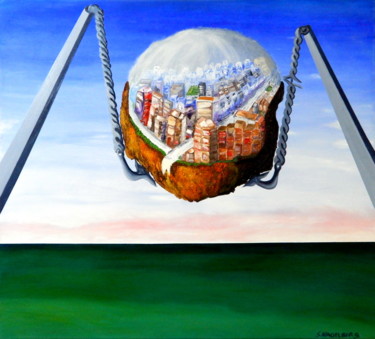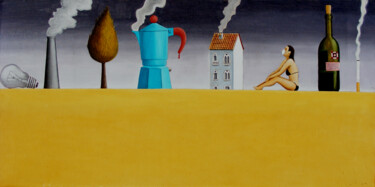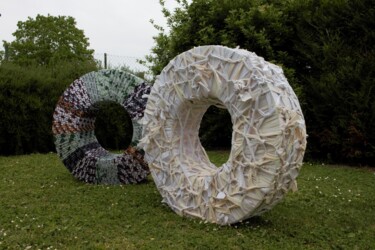 Vincent Bardou, Save the Planet, 2022. Spray paint / acrylic / ink / lacquer on canvas, 100 x 70 cm.
Vincent Bardou, Save the Planet, 2022. Spray paint / acrylic / ink / lacquer on canvas, 100 x 70 cm.
Turner, Monet and Boccioni "precursors" of environmental art
The nineteenth- and twentieth-century reality, as told by artists, who, like Turner, Monet and Boccioni, documented, without any pretense of ecological denunciation, worthy of the more contemporary Environmental Art, Land Art and Ecological Art, the impact of industrialization on the environment, can be reread through the involvement of a more modern sensibility, capable of recognizing in these works, which simply show the fumes of factories and railroads, a valuable document of the first changes imposed by man on the environment. The aforementioned masters approached progress through different ideological and stylistic modes, just as can be seen by analyzing some of their masterpieces, first and foremost Turner's Rain Steam and Speed (1844), Monet's La Gare de Saint Lazare (1877) and Boccioni's Gli addi (1911). Beginning with the first masterpiece, it was created through a flurry of brushstrokes designed to highlight the rapid and dynamic passage of a train, which, facing the falling rain, opposes the static nature of its own steam released into the atmosphere. The work, depicting the Great Western Railway train passing over the Maidenhead railway bridge, is a document capable of demonstrating how the British artist was so fascinated by the "fledgling" nineteenth-century locomotive that he went so far as to pay homage to it in a work, which, in addition to depicting the uncommon pictorial subject of the train, celebrates the power of human ingenuity, as the locomotive does not dare to yield in the face of incessant rain, but seems almost to defy it, giving a foretaste of the future of technology, in time increasingly recognizable as a force capable of countering and overpowering nature. Turner celebrated this new "entity" but was unaware of its harmful aspects, as, at the time, little or no knowledge of pollution was known, so much so that factories and trains were springing up and spreading relentlessly. Another work by the master aimed at giving us a glimpse of the face of progress and industrialization at the time is An Industrial Town at Sunset, Probably Birmingham or Dudley (c. 1830), a color study marked by the presence of a "heavy" atmosphere, in which the red of the sunset, the thick fog and the fumes of an industrial town in the Midlands, probably Dudley, the place where a steam engine was first put into operation, blend together.
 J. M. W. Turner, Rain, Steam and Speed – The Great Western Railway, 1844. Oil on canvas, 91 x 121.8 cm.
J. M. W. Turner, Rain, Steam and Speed – The Great Western Railway, 1844. Oil on canvas, 91 x 121.8 cm.
 Umberto Boccioni, The Farewells, 1911. Oil on canvas, 70.5 x 96.2 cm. New York: Museum of Modern Art (MoMA).
Umberto Boccioni, The Farewells, 1911. Oil on canvas, 70.5 x 96.2 cm. New York: Museum of Modern Art (MoMA).
Turning to France, it is a must to talk about Monet, a master who, similarly to Turner was fascinated by progress, so much so that he depicted it in a series of four paintings having the same subject, namely The Gare de Saint Lazare, within which the hymn to its locomotives and their corresponding fumes is manifested, which in this case, are depicted as a kind of distinct clouds in the atmosphere, rather than well amalgamated with it and its multiple phenomena. Regarding The Saint-Lazare Station (1877), the oil on canvas depicts the arrival section of the tracks of the aforementioned Parisian place, highlighting the "dark" presence, almost a kind of silhouette, of two locomotives advancing toward the station passing below the command bridge, immersed in the fumes of the steam, which, despite its insistent presence, allows a glimpse of some large buildings of the city, cleverly arranged in the background. A series of Monet's later works investigate, on the other hand, Waterloo Bridge in London, and perhaps somewhat because of the similar location, are influenced by Turner's atmospheres, in which the "veiled" landscape reveals the inevitable fusion of weather and pollution. A more "synthetic" and less realistic approach to this subject, on the other hand, is provided to us by the 1899 pastel, which, titled The Waterloo Bridge in London, binds the fumes of industries only in the upper part of the work, namely that of the small sky located just above the bridge. In terms of the pastel style, the spans of the bridge were drawn with thick, juxtaposed lines, having the purpose of creating a compact architectural mass. The flow of water, on the other hand, is the result of soft, undulating lines, more accurate than the few vertical and horizontal marks that characterize the city in the background. In order to conclude with France, it is also worth mentioning Gustave Caillebotte's view of pollution, rendered by The Bridge of Europe, a painting that, having the purpose of capturing one of the most modern places in the Paris of the 1870s, located above the teeming Gare Saint-Lazare, arranges the traces of steam in the background, privileging a view of the city, aimed at highlighting the stroll of Parisians of the time, still far from discovering the nefarious effects of progress on the environment. To conclude, we come to early 20th-century Italy, a nation in which, in contrast to the above, the Futurist movement came to celebrate the machine, speed and progress, taking them to a higher state than mere admiration, that is, transforming them into veritable cult objects, aimed at creating an artistic point of view drastically arrayed against stasis and immobility. Summing up what has been said is the point of view expressed by one of the most celebrated Futurists, Umberto Boccioni, a master who in Gli addi, a 1911 canvas, preserved at Moma (New York) and part of the Stati d'Animo series, depicts a locomotive, which, advancing rapidly, generates a tangle of circular lines, which intersect with the other horizontal ones. This view, in which "6943" stands out, that is, the identification number of the train that generates smoke from its smokestack, is probably the result of the time the artist spent observing the scenes of greetings, arrivals and departures at the Milan train station, a city depicted in another masterpiece by the Italian, again on an "ecological" subject. The work in question is Officine di Porta Romana, which set in today's fashion and luxury district, adjacent to the Prada Foundation, was painted by the master, who, from his home on Via Adige, used to draw inspiration by admiring from his window the distant fumes of a city always in turmoil. Finally, contemporary views on the pollution-art binomial are offered to us by the figurative investigation of Artmajeur painters, such as, for example, Ronald Houriez, Anita Kaufmann and Victor Molev.
 Andrea Vandoni, On the horizon, 2010. Oil on canvas, 50 x 100 cm.
Andrea Vandoni, On the horizon, 2010. Oil on canvas, 50 x 100 cm.
 Edith Donc, Breathe!, 2010. Acrylic on canvas, 92 x 73 cm.
Edith Donc, Breathe!, 2010. Acrylic on canvas, 92 x 73 cm.
 Ronald Houriez, Planet A, 2022. Oil on Linen Canvas, 116 x 116 cm.
Ronald Houriez, Planet A, 2022. Oil on Linen Canvas, 116 x 116 cm.
Ronald Houriez: Planet A
This painting, which frames a squashed can of coke against an indistinct celestial background, is designed to have a strong emotional impact, as, without much ado, the viewer comes face to face with one of those most classic garbage, which, due to human "carefreeness," we often encounter while walking through our cities, bathing in the waters of the sea or enjoying the pleasures of country life. The artist himself, in order to describe Planet A, begins with clear, direct, concise and unequivocal words, according to which, the work would represent the "archetype of neglect and disregard for the environment." This sentence, which resonates like a slap in the face, aimed at hitting a face of those who, almost dumbfounded, have long persisted in disregard, brings even the most recidivist back to reality, making them aware of the need for drastic change. At this point, art history presents itself as a kind of fearless champion of the environment, which, rich in "eco friendly" works, allows us to associate, somewhat imaginatively and daringly, Houriez's work with Pam Longobardi's Bounty, Pilfered. In fact, since the painting Planet A is devoid of a background, we can, by letting our imagination operate, imagine it coming out of the polluted hornpipe of the aforementioned American eco-feminist artist. Speaking of the latter, her Houriez with Bounty was conceived with the intention of providing an unequivocal visual statement about global consumption and the impact of plastic objects on the world's places and creatures. Such a message has forever transformed the symbolic value of the cornucopia, which as an ancient manifesto of abundance, has oftentimes peeped into Greek and Roman works of art, alluding to the more beneficent mythological meanings of prosperity, abundance and good fortune.
 Anita Kaufmann, Save our ocean no. 1722, 2022. Acrylic on canvas, 70 x 100 cm.
Anita Kaufmann, Save our ocean no. 1722, 2022. Acrylic on canvas, 70 x 100 cm.
Anita Kaufmann: Save our ocean no. 1722
Abstractism and the conceptual come together in Anita Kaufmann's work, in which, the meaning of the "rebus," composed of the apparent sequence of nonsense words, is revealed to us by the artist herself, who admits that she has resorted to the ICAO alphabet in order to launch an important message of denunciation: "Defend and protect our ocean." At this point, the viewer may wonder: why did Kaufmann choose an "inaccessible" language in order to express a concept that absolutely must be understandable by everyone at first glance? In fact, it is often precisely what is comprehensible that is not conducive to the interest and attention of the viewer, who, when instead stimulated and involved in a profound attempt at interpretation, will not easily forget the message deciphered with so much effort. As far as art history is concerned, on the other hand, a masterpiece, "partly Pop partly abstract," with similar intentions, is Robert Rauschenberg's Last Turn - Your Turn (1991), a composition conceived by the American in support of the Earth Summit (Rio de Janeiro, 1992), the United Nations Conference on Environment and Development, which aimed to bring attention to the damage to our planet due to pollution and excessive consumption of resources. Precisely in this context, Robert Rauschenberg's work pursued the goal of raising public awareness about the aforementioned environmental issues, spreading a message aimed at highlighting how, in addition to the importance of government initiatives, individual action is necessary. In order to promote the latter's commitment, the only one capable of making legislative measures actually effective, Rauschenberg set a good example by enriching the masterpiece with an inscription charged with personal responsibility: "I pledge to make the Earth a safe and hospitable place for present and future generations."
 Victor Molev, Safari, 2008. Oil on Canvas, 51x 76 cm.
Victor Molev, Safari, 2008. Oil on Canvas, 51x 76 cm.
Victor Molev: Safari
Usually, when we imagine murder, we think of a man, or a woman, armed with a weapon to hurl at a poor, innocent unfortunate, a fearsome attacker, etc. Now, if, similarly, we imagine seeing an animal suffocating in oil, we notice how, in reality, pollution is a silent, faceless killer, capable of presenting itself in the multitude of forms of the consequences of human action. A thankfully less lethal example of what has just been stated is offered to us by the trash-spewing seagull in Plasticide, part of a 2016 installation by Jason deCaires Taylor, a British artist who in the sadly constipated bird wanted to summarize this concept: "our oceans, and the marine life that inhabits them, literally cannot digest any more plastic." As anticipated, in the aforementioned work, it does not appear man, the cause of the world's drift, but waste, its direct descendant, while, on the other hand, in the work of the artist from Artmajeur to the probable fumes of pollution the devastating presence of mankind, aimed at pouncing on the most disparate living species, is also revealed. In the words of Molev himself: the work "reflects the theme of ecology, environmental protection and man's reckless attitude to the extinction of rare animal species."


 Olimpia Gaia Martinelli
Olimpia Gaia Martinelli























